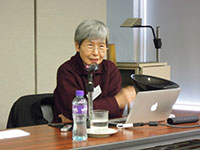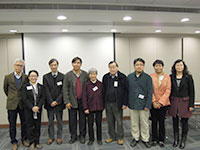 Professor Fan graduated from Peking University's Department of History in 1963, and since then her archaeological research has been concerned with the scientific conservation and management of the Mogao Grottoes. Due to her outstanding contributions to the preservation and utilisation of this precious cultural resource, Professor Fan has become known as "the daughter of Dunhuang". Professor Fan graduated from Peking University's Department of History in 1963, and since then her archaeological research has been concerned with the scientific conservation and management of the Mogao Grottoes. Due to her outstanding contributions to the preservation and utilisation of this precious cultural resource, Professor Fan has become known as "the daughter of Dunhuang".
Professor Fan first briefly introduces the background and value of the Mogao Grottoes in Dunhuang. She states that as an important town on the ancient Silk Road, Dunhuang has a history of more than two-thousand years so far. The Mogao Grottoes in Dunhuang has kept enormous precious documents and works of arts. It was designated as a World Heritage Site by the UNESCO in November, 1987. Located in the desert, where the climate is dry and there is little rain, the environment of the caves of the Mogao Grottoes is relatively constant. The mineral-derived materials used to create the murals are also relatively stable, and there have been no great wars or upheavals in the area. These factors account for the survival of the Mogao Grottoes. However, the effects of nature and people over time do threaten their future preservation. There was a major disruption in the mid-sixteenth century, when the government of the Ming dynasty built the Jiayu Pass and ordered all citizens living to the west of the pass to move to the other side, which resulted in the departure of the founders of the Mogao Grottoes. Over time, they were gradually forgotten, and endured all kinds of damage, from both natural and human forces. They were in a state of serious neglect when in 1944, 400 years later, a conservation institution was established. Professor Fan continued by describing four major threats to the Mogao Grottoes. The first is wind and sand erosion. Located on the edge of the Gobi desert, the Mogao Grottoes are constantly bombarded by sandstorms, which results in the weathering of the rocks. Sand blown into the caves may result in abrasions on the paintings. Mildew may affect the murals, caused by water brought into the caves by sand. Removing the large quantity of accumulated sands is also a major challenge. The second threat comes from soluble salt. A plaster layer, mixed with grass and mud, covers the rock surface. The many cracks in this plaster allow water to get beneath the layer and dissolve the salt in the rock, which causes the wall paintings to deteriorate, causing extensive damage. The third threat is from geological upheavals. The rocks of the Mogao Grottoes are mainly sandstone, and cracks are abundant in the structure. There is a risk of the rocks collapsing if there is an earthquake. The Mogao Grottoes are located in the Gansu Corridor, which is on the edge of an earthquake zone. Reinforcement of the rock structure thus becomes necessary. Flooding is another threat. Seasonal rainstorms cause floods, which can wash away soil, weakening the base of the rocks resulting in their collapse. The last threat comes from visitors. Many people have visited the Mogao Grottoes since they were opened to the public. Most of the caves in the Mogao Grottoes are small, very old and very fragile, and the large number of visitors will disturb the relatively stable environment in the caves, and worsen any existing damage. The conservation of the Mogao Grottoes is very complicated. Smaller artefacts such as bronze items can be moved and their environments controlled. As single, standalone pieces, any damage is more straightforward to repair, and the preservation works is therefore less complicated. The larger, fixed relics however cannot be moved out of the uncontrollable environment. The rocks and caves have usually gone through numerous reconstructions and are made from more complex materials, resulting in more complex damage. This leads to great challenges for conservation. The Mogao Grottoes went through constant reconstructions over a period of a thousand years, and were then abandoned for over four hundred years. The various changes the grottoes have been subjected to have led to very complex damage. The history and culture of the Mogao Grottoes are inextricably linked to the surrounding cultural and natural environment: the temples, towers, original oases and the Gobi Desert. Because of this, and because of their remarkable value, Professor Fan stated that the Mogao Grottoes need to be properly utilised and publicised, as well as conserved. Besides technologies, various management policies such as enactment of laws and regulations are also essential for the conservation of the Mogao Grottoes. In 1944, the National Research Institute on Dunhuang Art was established by the national government. It was renamed the Research Institute on Cultural Relics of Dunhuang in 1950, and further broadened to become the present Dunhuang Academy in 1984. The conservation and management of the Mogao Grottoes has been overseen by several generations. Professor Fan reviewed the history of three main stages: - 1944-1949, the period of the National Research Institute on Dunhuang Art. The first director of the National Research Institute on Dunhuang Art was the renowned painter Chang Shuhong. Leading a group of specialists, Chang and his staff cleared the sand that had accumulated inside the caves over the past several hundred years, removed the earth beds and clay ovens constructed by people who lived inside the caves, repaired caves doors and built a wall around the Mogao Grottoes to prevent further damage from blowing sands and trespassers. They copied the murals, numbered the caves, organised exhibitions and carried out other difficult, but pioneering, work.
- 1950-1966, the period of the Research Institute on Cultural Relics of Dunhuang. Over this time, Chang Shuhong recruited more staff to investigate the environmental mechanisms responsible for the damage to the Mogao Grottoes and carried out conservation works to save some of the relics, which included restoring the statues to their original positions, using new techniques and materials to deal with the problem of soluble salt, and so on. Premier Zhou Enlai approved funding of more than one million RMB to reinforce the rock structure of the Mogao Grottoes. Able to resist a magnitude 7 earthquake, this reinforcement project is essential to the conservation of the Mogao Grottoes.
- 1980-present, the period of the Dunhuang Academy. During the Cultural Revolution, the conservation of the Mogao Grottoes almost came to a halt. Fortunately none of the relics were damaged. During the period of reform in China, the Dunhuang Academy continued to collaborate with other domestic and foreign institutions, offer training and exploring new scientific research and management methods. The conservation of the Mogao Grottoes entered a new scientific stage.
Professor Fan introduced this stage of the new era from three perspectives:
- Legislation
The conservation of the Mogao Grottoes follows both the relevant laws and regulations passed by UNESCO and the Chinese government's laws on relic preservation. The conservation work must also abide by strict rules. From 1998 to 2004, four institutes from three countries; the Dunhuang Academy, the Getty Conservation Institute of the USA, the Australian Heritage Council and the Research Institute of Architecture History of the China Architecture Design and Research Group, worked together to devise a twenty-year plan for the conservation of the Mogao Grottoes, from 2006 to 2025. Based on relevant laws and regulations, this plan is enacted by the government and is the foundation for the conservation efforts concerning the Grottoes.
- Conservation of the Cliffs
Works on this aspect include injecting grouting material to restore and consolidate the cliff surface, extending the height of the passageway to ensure the safety of visitors and collaborating with foreign specialists to repair murals. Professor Fan was particularly concerned with how the project deals with the threat of sand. The comprehensive approach, using grass grids, shrub belts, sand barriers and stones (to compact the sand), has reduced the amount of sand blown into the Mogao Grottoes by 75%.
- Prevention and Monitoring
To deal with the many long-term factors affecting the conservation of the Mogao Grottoes, Professor Fan explained how they need to continually monitor various threats, to prevent future damage. For example, to deal with the problem of increasing visitor numbers, they carried out a project to research "The Influence of Visitor Load to the Mogao Grottoes," to calculate the optimum number of visitors per day and the tolerances of the micro-environment of the caves, so the caves can be safely opened to the public and the cultural experience can be fully enjoyed. Preventative conservation of the Mogao Grottoes also includes storing digital images of the relics as a permanent record, introducing an online booking system for visitors, establishing special routes during peak seasons and opening a visitor centre to alleviate visitor pressure, maintaining international collaborations and skill training.
 Professor Fan concluded by saying that although the conservation and management of the Mogao Grottoes has reached a new level, due to the continuous efforts over the past years, the work will never come to an end, while the Mogao Grottoes still exist. She points out that in the future, they will face many new problems. Active prevention should continue and increase, to maintain a balance between preservation and public viewing, to continue training and to collaborate with domestic and international institutions. Professor Fan concluded by saying that although the conservation and management of the Mogao Grottoes has reached a new level, due to the continuous efforts over the past years, the work will never come to an end, while the Mogao Grottoes still exist. She points out that in the future, they will face many new problems. Active prevention should continue and increase, to maintain a balance between preservation and public viewing, to continue training and to collaborate with domestic and international institutions.
|














